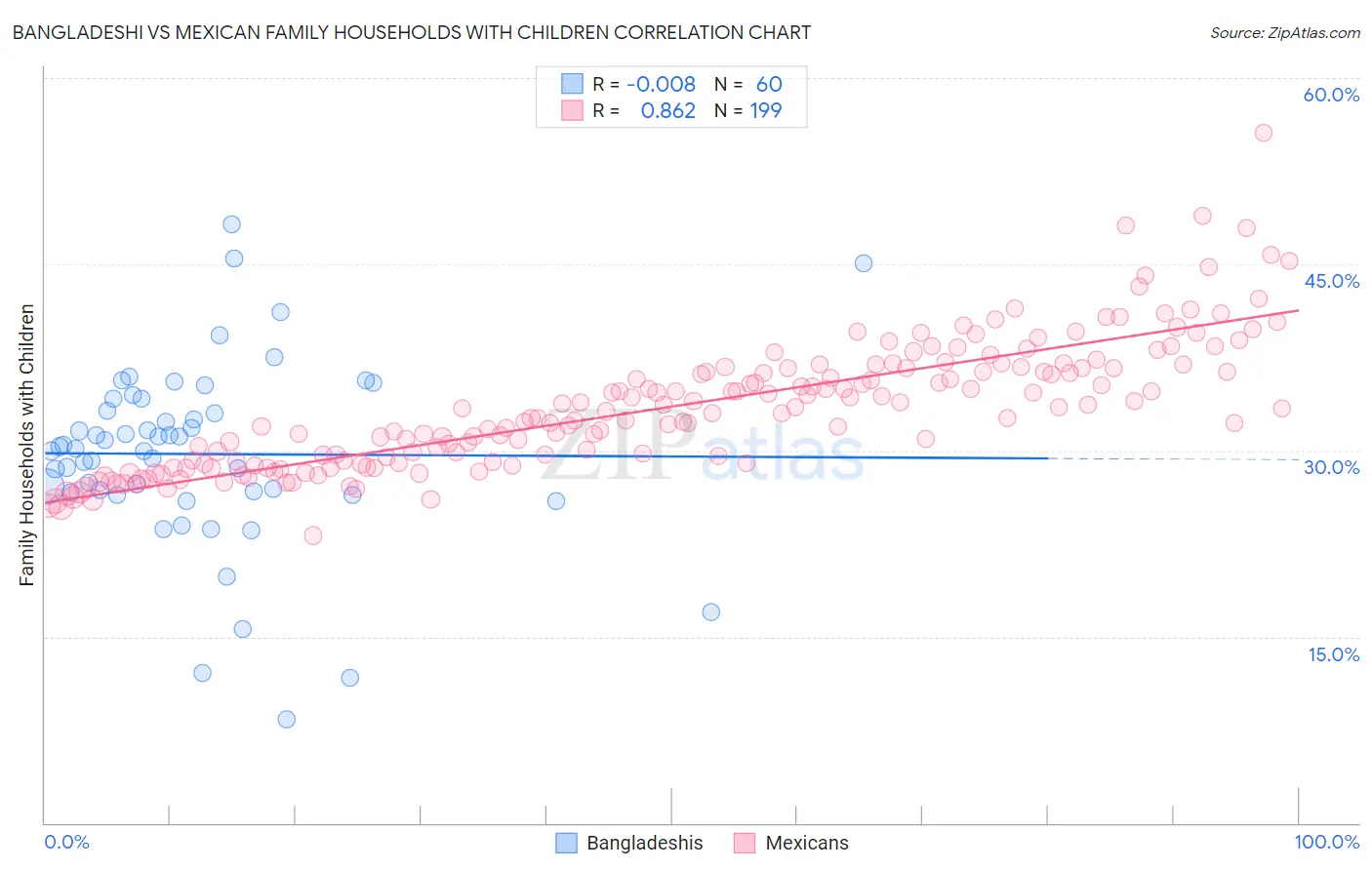Bangladeshi vs Mexican Family Households with Children
COMPARE
Bangladeshi
Mexican
Family Households with Children
Family Households with Children Comparison
Bangladeshis
Mexicans
30.1%
FAMILY HOUSEHOLDS WITH CHILDREN
100.0/ 100
METRIC RATING
14th/ 347
METRIC RANK
31.4%
FAMILY HOUSEHOLDS WITH CHILDREN
100.0/ 100
METRIC RATING
4th/ 347
METRIC RANK
Bangladeshi vs Mexican Family Households with Children Correlation Chart
The statistical analysis conducted on geographies consisting of 141,328,833 people shows no correlation between the proportion of Bangladeshis and percentage of family households with children in the United States with a correlation coefficient (R) of -0.008 and weighted average of 30.1%. Similarly, the statistical analysis conducted on geographies consisting of 564,219,663 people shows a very strong positive correlation between the proportion of Mexicans and percentage of family households with children in the United States with a correlation coefficient (R) of 0.862 and weighted average of 31.4%, a difference of 4.2%.

Family Households with Children Correlation Summary
| Measurement | Bangladeshi | Mexican |
| Minimum | 8.3% | 23.2% |
| Maximum | 48.3% | 55.6% |
| Range | 39.9% | 32.5% |
| Mean | 29.7% | 33.5% |
| Median | 30.2% | 33.1% |
| Interquartile 25% (IQ1) | 26.6% | 29.1% |
| Interquartile 75% (IQ3) | 33.7% | 36.6% |
| Interquartile Range (IQR) | 7.1% | 7.6% |
| Standard Deviation (Sample) | 7.4% | 5.2% |
| Standard Deviation (Population) | 7.4% | 5.2% |
Demographics Similar to Bangladeshis and Mexicans by Family Households with Children
In terms of family households with children, the demographic groups most similar to Bangladeshis are Immigrants from South Central Asia (30.0%, a difference of 0.17%), Immigrants from Afghanistan (30.0%, a difference of 0.20%), Afghan (30.2%, a difference of 0.28%), Immigrants from Pakistan (30.2%, a difference of 0.52%), and Hispanic or Latino (29.9%, a difference of 0.58%). Similarly, the demographic groups most similar to Mexicans are Tongan (31.2%, a difference of 0.41%), Immigrants from Mexico (31.6%, a difference of 0.78%), Immigrants from India (31.0%, a difference of 1.0%), Immigrants from Central America (31.0%, a difference of 1.3%), and Yakama (30.8%, a difference of 1.9%).
| Demographics | Rating | Rank | Family Households with Children |
| Yup'ik | 100 /100 | #1 | Exceptional 37.0% |
| Inupiat | 100 /100 | #2 | Exceptional 32.8% |
| Immigrants | Mexico | 100.0 /100 | #3 | Exceptional 31.6% |
| Mexicans | 100.0 /100 | #4 | Exceptional 31.4% |
| Tongans | 100.0 /100 | #5 | Exceptional 31.2% |
| Immigrants | India | 100.0 /100 | #6 | Exceptional 31.0% |
| Immigrants | Central America | 100.0 /100 | #7 | Exceptional 31.0% |
| Yakama | 100.0 /100 | #8 | Exceptional 30.8% |
| Thais | 100.0 /100 | #9 | Exceptional 30.6% |
| Immigrants | Fiji | 100.0 /100 | #10 | Exceptional 30.5% |
| Nepalese | 100.0 /100 | #11 | Exceptional 30.5% |
| Immigrants | Pakistan | 100.0 /100 | #12 | Exceptional 30.2% |
| Afghans | 100.0 /100 | #13 | Exceptional 30.2% |
| Bangladeshis | 100.0 /100 | #14 | Exceptional 30.1% |
| Immigrants | South Central Asia | 100.0 /100 | #15 | Exceptional 30.0% |
| Immigrants | Afghanistan | 100.0 /100 | #16 | Exceptional 30.0% |
| Hispanics or Latinos | 100.0 /100 | #17 | Exceptional 29.9% |
| Salvadorans | 100.0 /100 | #18 | Exceptional 29.9% |
| Alaska Natives | 100.0 /100 | #19 | Exceptional 29.9% |
| Immigrants | El Salvador | 100.0 /100 | #20 | Exceptional 29.8% |